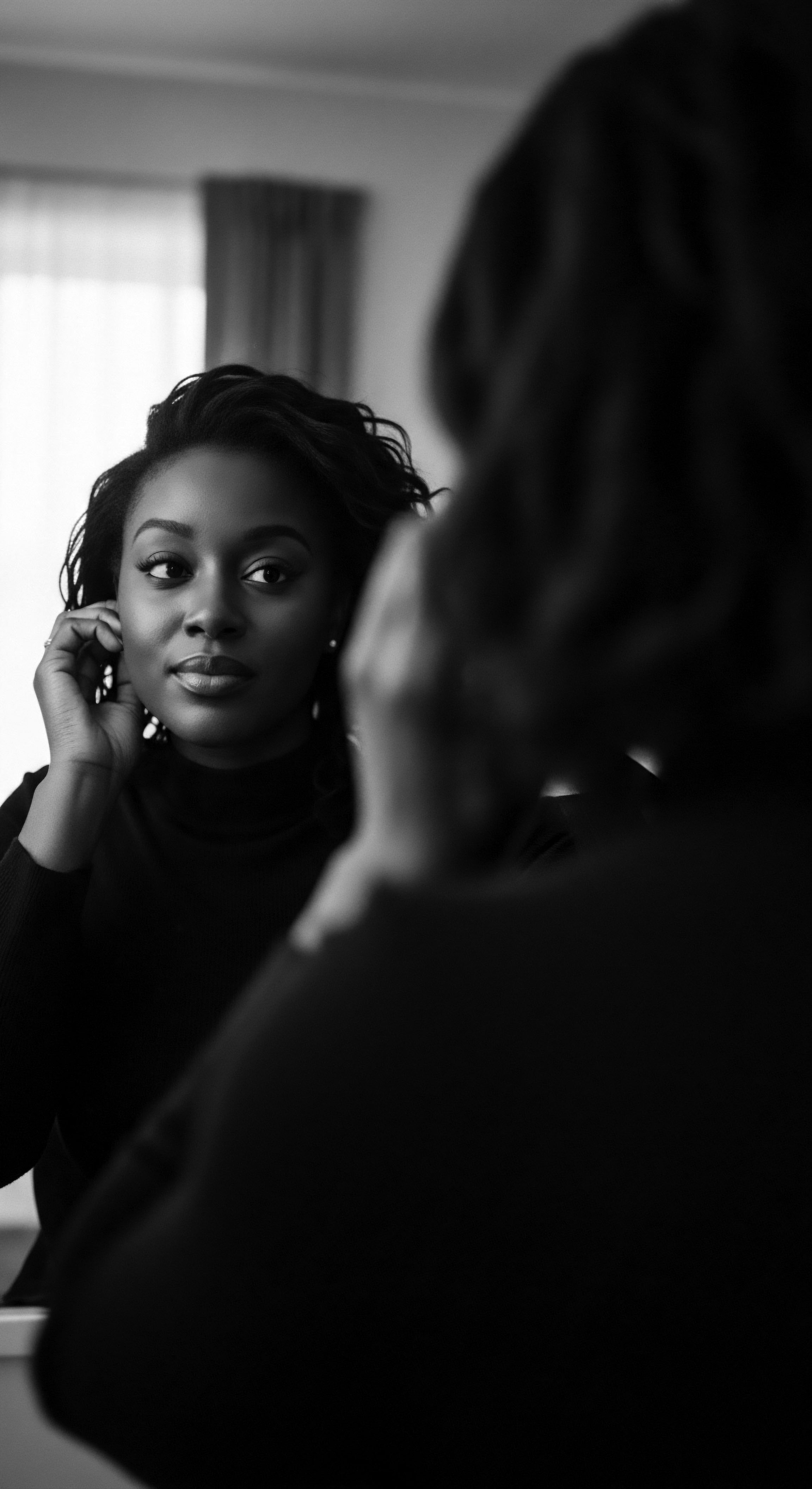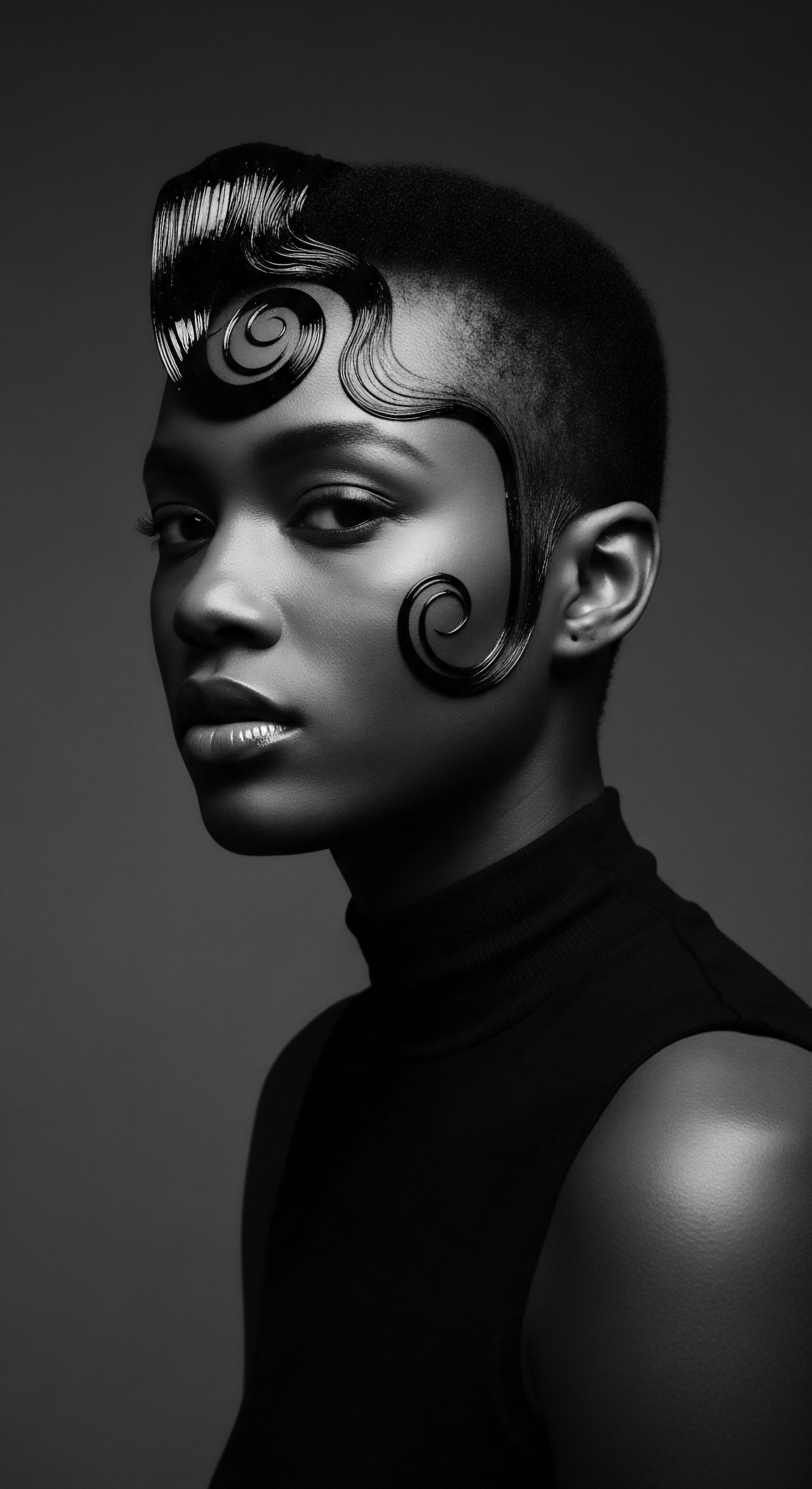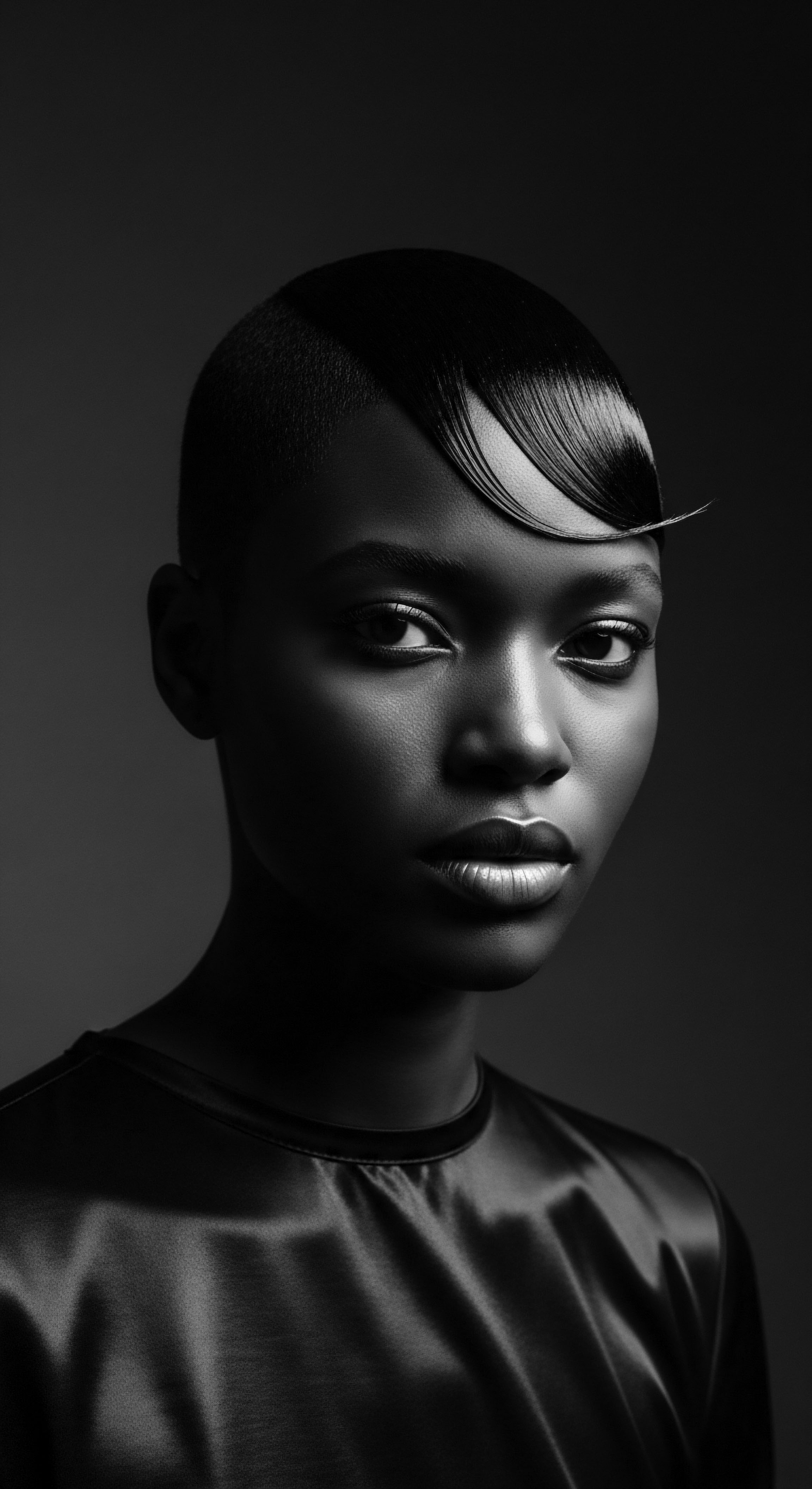
Roots
The story of textured hair, especially within Black and mixed-race communities, is a vibrant chronicle of resilience, ingenuity, and profound connection to ancestral ways. It is a story not merely of individual strands, but of collective identity, passed down through generations. To truly grasp the lasting influence of Madam C.J. Walker, we must first allow ourselves to sink into the deep soil from which her innovations sprung.
Consider the intimate moments shared on a porch, hands gently working through coils and kinks, not just for beauty, but for spiritual well-being, for community bonding, for silent acts of resistance against a world that sought to diminish Black existence. This is the sacred ground upon which Madam Walker built, her legacy echoing the very cadences of those communal rituals.

What is the Fundamental Understanding of Textured Hair from a Historical and Scientific Heritage Perspective?
Textured hair, with its unique helical structure, carries a history far older than any product bottle. Its varied curl patterns, from broad waves to tight coils, are a marvel of natural engineering, distinct from straight or wavy hair types due to the elliptical shape of the hair follicle and the way keratin proteins align. This biological design creates a hair strand that can be prone to dryness due to the difficulty of natural oils traveling down its curves, and susceptible to breakage from manipulation. Understanding this intrinsic biology is essential, yet the perception and care of textured hair have always been intertwined with broader cultural currents.
Before the transatlantic slave trade, hair in various African societies served as a sophisticated visual language. It indicated status, age, marital standing, tribal affiliation, and even spiritual beliefs. Styling was a ceremonial act, often involving natural butters, herbs, and powders to nourish and protect the hair. The intricate cornrows, braids, and adornments were not merely aesthetic choices; they were living expressions of heritage and communal belonging.
When enslaved Africans were forcibly brought to the Americas, a deliberate effort was made to strip them of their cultural markers, including their hair traditions. Hair was often shaved or forcibly altered, a brutal act designed to sever ancestral ties and dehumanize. Yet, even in the harshest conditions, the spirit of hair care persisted, with individuals finding ways to maintain some semblance of their heritage through hidden braiding patterns or improvised remedies using what little was accessible. This perseverance speaks to the enduring power of hair as a symbol of selfhood and continuity.
The story of textured hair is not merely cosmetic; it is a profound testament to enduring selfhood and continuity, woven into the very fabric of Black and mixed-race heritage.

How Did Societal Views Shape Textured Hair Terminology?
The language used to describe textured hair has a complicated lineage. Early European encounters often categorized Black hair as “wool,” a dehumanizing term that laid a foundation for discriminatory beauty standards that privileged straight hair. This problematic categorization influenced perceptions for centuries, leading to a pervasive notion of “good hair” (meaning straight or wavy) and “bad hair” (referring to tightly coiled textures). These terms, rooted in colonial and post-slavery ideologies, shaped not only individual self-perception but also the market for hair care products.
Modern classification systems, such as those using numbers and letters (e.g. 3C, 4A, 4B, 4C), aim to provide a more descriptive, less judgmental vocabulary for curl patterns. However, even these systems carry a historical echo. Early versions, particularly in the early 20th century, were sometimes developed with intentions rooted in racial categorization, seeking to determine an individual’s “proximity to whiteness” based on hair texture.
While contemporary use seeks a neutral, descriptive purpose, understanding this troubled past is essential for anyone wishing to engage with textured hair care in a truly heritage-conscious manner. The goal is to describe, not to rank, to celebrate the diversity of coils and kinks without internalizing the old, harmful binaries.
- Traditional Care Practices ❉ African communities used natural oils, butters, and herbs like shea butter, coconut oil, and aloe vera for hair health and moisture.
- Styling as Identity ❉ Braiding, cornrows, and adornments with beads or shells were historically used to convey social status, tribal affiliation, and spiritual connection.
- Post-Slavery Adaptation ❉ Enslaved people often used improvised ingredients, such as kerosene or bacon grease, for hair care due to lack of traditional resources.

Ritual
Madam C.J. Walker entered a world where the ritual of hair care for Black women was deeply personal, often private, and profoundly influenced by both ancestral memory and the harsh realities of American society. Her contribution went beyond mere commerce; she transformed a neglected corner of self-care into an industry, providing not just products but a system, a method, and a network that offered economic independence. Her approach, rooted in addressing scalp health and hair growth, redefined what was possible for textured hair, creating a new ritual grounded in well-being and community.

How Did Walker’s Legacy Shape Styling Heritage and Transformation?
Walker’s entrepreneurial spirit arose from her own experience with hair loss and scalp conditions, common issues at a time when many Americans lacked indoor plumbing and effective hygiene products were scarce. She recognized a gaping void in the market ❉ products specifically tailored for the needs of Black women, who often used damaging concoctions or struggled with unaddressed scalp ailments. Her “Walker System” was a holistic approach that included scalp preparation, lotions, and application techniques, emphasizing regular cleansing and the use of a healing pomade. This system offered a structured regimen, a ritual, where none effectively existed before, allowing women to improve the health of their hair and scalps.
While Walker did not invent the hot comb, a tool used for thermal straightening, she certainly popularized its use and integrated it into her system. This aspect has sometimes led to a complex, even ambivalent, view of her legacy, with some associating her with the promotion of Eurocentric beauty standards. Yet, Walker consistently argued that her products were about health and growth, not about fundamentally altering hair texture. She aimed to heal scalps and grow hair, providing women with more options and confidence, whether they chose to wear their hair straightened or in its natural state.
The hot comb, in her view, offered a gentler alternative to earlier, more damaging straightening methods. This focus on choice and healthy foundations for styling, rather than rigid adherence to one look, allowed a greater range of transformations for Black women, even as societal pressures for straightened hair persisted.
Walker’s work provided Black women not just products, but a structured system for hair health, transforming personal care into an economic and communal ritual.

What Role Did Styling Techniques and Tools Play in Her System?
The “Walker Method” extended beyond just products; it encompassed specific techniques and tools. It included a vegetable shampoo, gentler than harsh lye soaps common at the time, promoting more frequent washing for scalp hygiene. The application of her “Wonderful Hair Grower,” a pomade often containing ingredients like sulfur, petrolatum, and coconut oil, was accompanied by scalp massage, believed to stimulate growth and improve scalp condition. These practices, while using modern (for her time) formulations, echoed ancient African traditions that emphasized scalp health and the use of natural ingredients for sustenance and growth.
Her company, the Madam C.J. Walker Manufacturing Company, trained thousands of “Walker Agents” or “beauty culturists” across the country and even internationally. These women were not merely saleswomen; they were educators, demonstrating the Walker System and providing personalized care. This network created a communal space around hair care, fostering a sense of shared knowledge and collective upliftment.
This structure, a precursor to modern direct sales and multi-level marketing, ensured that professional hair care practices reached Black women in their communities, even in segregated areas where access to other beauty services was limited. The agents brought with them not just products, but a new understanding of hair science and a shared ritual of care.
| Walker System Component Scalp Health Focus |
| Historical Application and Heritage Connection Addressed prevalent scalp ailments and hair loss; shifted away from solely aesthetic concerns to foundational well-being. Echoes ancestral practices prioritizing scalp nourishment. |
| Modern Parallel and Influence Emphasis on microbiome balance, anti-dandruff treatments, and specialized scalp serums for textured hair. |
| Walker System Component "Wonderful Hair Grower" |
| Historical Application and Heritage Connection A pomade with medicinal properties (sulfur, petrolatum, coconut oil) for scalp healing and growth. Its name spoke to a desire for healthy, growing hair. |
| Modern Parallel and Influence Modern hair growth serums, nourishing oils, and scalp treatments that aim for stronger, denser hair. |
| Walker System Component Regular Cleansing (Vegetable Shampoo) |
| Historical Application and Heritage Connection Advocated for more frequent, yet gentle, shampooing at a time when indoor plumbing was rare, improving hygiene. |
| Modern Parallel and Influence Development of sulfate-free shampoos, co-washes, and low-poo cleansers that respect textured hair's moisture needs. |
| Walker System Component "Walker Agents" Network |
| Historical Application and Heritage Connection Thousands of trained Black women provided personalized care, education, and economic opportunity in their communities. |
| Modern Parallel and Influence Rise of specialized natural hair stylists, online communities, and Black-owned beauty brands offering tailored advice and products. |
| Walker System Component Madam Walker’s foundational ideas, particularly her emphasis on health and community, laid early groundwork for today’s comprehensive textured hair care. |

Relay
The deep currents of Madam C.J. Walker’s legacy continue to flow through modern textured hair care, a relay of wisdom and ingenuity across generations. Her approach transcended simple product sales; it established a paradigm of self-care and economic agency that still resonates.
We observe this influence in the very structure of the textured hair market, the emphasis on specific ingredients, and the philosophical underpinnings of today’s natural hair movements. The spirit of her work, deeply rooted in Black women’s experiences and ancestral practices, finds new expressions in a contemporary landscape.

How does Walker’s Legacy Inform Holistic Care and Problem-Solving Rooted in Heritage and Ancestral Wisdom?
At the heart of Madam Walker’s enduring influence lies her holistic perspective on hair care. She understood that hair health was intertwined with overall well-being and, crucially, with the dignity and economic independence of Black women. This broad view extended beyond mere aesthetics. Her focus on healing scalp issues and promoting hair growth addressed fundamental problems faced by many Black women of her era, who often grappled with damaged hair from harsh products and poor hygiene conditions.
This proactive, problem-solving approach, centered on the health of the scalp as the source of healthy hair, mirrors ancient African practices where medicinal plants and natural ingredients were used to treat scalp conditions and encourage vitality. The modern textured hair community, with its widespread interest in ingredients like shea butter, coconut oil, and traditional powders like Chebe (from Chad, used for hair growth and retention), often seeks to replicate this ancestral wisdom, validating Walker’s early intuition.
The current movement towards “clean beauty” and natural ingredients in textured hair care also echoes Walker’s original intent. While some of her products included mineral oil and petrolatum, which were considered advanced for their time, her vegetable shampoo was a gentler alternative to the lye-based soaps often used for hair washing. This early inclination towards less harsh formulations finds continuity in today’s preference for sulfate-free cleansers, natural oils, and products designed to nourish without stripping.

What Traditions Did Madam Walker’s Practices Build Upon?
Madam Walker’s methods, though pioneering for their time, did not materialize in a void. They built upon, and sometimes diverged from, existing Black hair traditions that had survived the brutality of slavery. Prior to emancipation, many enslaved Africans continued to practice hair care in secret, using what was available to them – from plant oils to creative braiding to hide mapping routes to freedom. Post-emancipation, Black women still faced immense societal pressure to conform to Eurocentric beauty standards, often feeling the need to straighten their hair to secure jobs or social acceptance.
In this context, Walker’s system offered a structured, accessible means to achieve a desired look while simultaneously promoting scalp health, a concept often overlooked by mainstream products. Her use of heated combs, while contributing to straightening, was also presented as a hygienic improvement over earlier, more dangerous methods. Her emphasis on “hair culture” and the “Walker System” provided a framework that acknowledged the specific needs of Black hair, rather than simply attempting to force it into European molds. This was a significant step toward self-determination within beauty practices.
Modern nighttime rituals, for instance, with the use of bonnets and silk scarves, directly extend a protective tradition. Historically, headwraps and scarves were worn for various reasons in African communities – for ceremonies, protection from elements, and to signify status. During slavery, headwraps became a means of maintaining dignity and protecting hair in harsh labor conditions.
Walker’s legacy, while perhaps not directly initiating the bonnet trend, laid the groundwork by promoting consistent hair care as a daily commitment, thereby validating the need for protective measures like those embraced today. The commitment to nightly wrapping, braiding, or twisting is a direct continuation of prioritizing hair health and preservation, an ethos profoundly shaped by her original message.
- Ingredient Legacy ❉ Modern conditioners and moisturizers often feature natural oils like coconut oil, shea butter, and castor oil, echoing traditional African remedies and Walker’s early formulations.
- Scalp Wellness ❉ The focus on scalp treatments, clarifying shampoos, and exfoliation aligns with Walker’s primary emphasis on scalp health as the foundation for growth.
- Community Empowerment ❉ The contemporary rise of Black-owned hair care brands and stylists who share knowledge and create safe spaces for textured hair care reflects the “for us, by us” model Walker pioneered.

Reflection
The living archive of textured hair history holds Madam C.J. Walker’s name etched with undeniable weight. Her journey, born from a personal struggle with scalp afflictions and hair loss, blossomed into a profound movement that reached far beyond the realm of beauty.
She created a commercial empire, yes, but simultaneously cultivated a deeply personal and communal transformation for Black women across the diaspora. Her legacy is not a static monument; it is a flowing river, constantly shaping the landscape of modern textured hair care routines.
The “Soul of a Strand” ethos finds deep resonance in Walker’s work. Each coil, each kink, is a testament to lineage, to the strength of generations, to the beauty that persevered through immense societal challenges. Walker understood this inherent value, even if the tools she popularized, like the hot comb, appear in hindsight to align with straightening trends. Her true intent, as many scholars assert, was hygiene, scalp health, and empowering Black women to achieve confidence and economic autonomy.
She saw an unmet need, a community underserved by prevailing beauty industries, and she rose to meet it with solutions tailored to their specific hair types and living conditions. This radical act of seeing and serving one’s own community is a core tenet of ancestral wisdom and continues to inform the best of textured hair care today.
Her creation of the “Walker System” established a replicable, accessible regimen, a concept that underpins every contemporary hair care routine from wash days to protective styling. The network of “Walker Agents” she trained not only disseminated products but also distributed knowledge, confidence, and a sense of collective purpose. This pioneering direct-to-consumer model, driven by Black women for Black women, laid the social and economic groundwork for generations of Black entrepreneurship in the beauty industry. The ripple effect of her vision is still felt in the vibrant ecosystem of Black-owned hair care brands that prioritize textured hair, often with explicit messages of self-acceptance and cultural pride.
When we consider the modern emphasis on scalp care, on moisture retention, on ingredients that nourish and fortify, we witness the quiet continuation of Walker’s original mission. The conversations around healthy hair, the rejection of harmful chemical processes, and the celebration of natural textures in their glorious diversity are all echoes of her foundational efforts to dignify and support Black women’s hair experiences. Her legacy serves as a constant invitation to look deeper, beyond surface aesthetics, to the profound connection between hair, health, heritage, and identity. It is a reminder that care for our strands is, truly, care for our souls.

References
- Bundles, A. (2001). On Her Own Ground ❉ The Life and Times of Madam C.J. Walker. Scribner.
- Byrd, A. D. & Tharps, L. R. (2001). Hair Story ❉ Untangling the Roots of Black Hair in America. St. Martin’s Press.
- Gill, T. M. (2010). Beauty Shop Politics ❉ African American Women’s Activism in the Beauty Industry. University of Illinois Press.
- Lashley, M. (2020). The importance of hair in the identity of Black people. Nouvelles Pratiques Sociales, 31(2), 206–227.
- Rooks, N. M. (1996). Hair Raising ❉ Beauty, Culture, and African American Women. Rutgers University Press.
- Thompson, C. (2009). Black Women and Identity ❉ What’s Hair Got to Do With It? University of Michigan.
- Walker, S. (2020). Style and Status ❉ Selling Beauty to African American Women, 1920–1975. University of Illinois Press.
